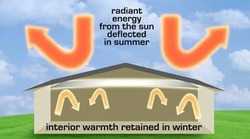
Department of Energy tests show that eShield attic energy barrier can deliver more energy savings than twelve inches of additional fiberglass insulation.
eSheild Frequently Asked Questions
Q: Why don’t building codes specify E-values as well as R-values?
A: In the last century, the only cost-effective insulation for the home was mass insulation like fiberglass, cellulose and foam that reduced heat transfer by convection and conduction. The “R-value” was the measure of how good a job those insulators did. Yet R-value measures only the smallest part of residential heat transfer. E-value is the measure of emissive, radiant heat transfer, the principle source of energy loss. New technologies make it practical to achieve extremely low emissive in window glass and in a reflective film ideal for the attic. As these low-E technologies advance, the codes will catch up and E-value will replace R-value as the primary measure of energy efficiency.
Q: Will eShield™ installed in my attic trap mildew-causing moisture in my ceiling?
A: eShield™ is perforated to allow vapor to escape the housing envelope – it will not contribute to mildew growth in your home.
Kevin McCrackin
972-341-7293
[email protected]
 RSS Feed
RSS Feed